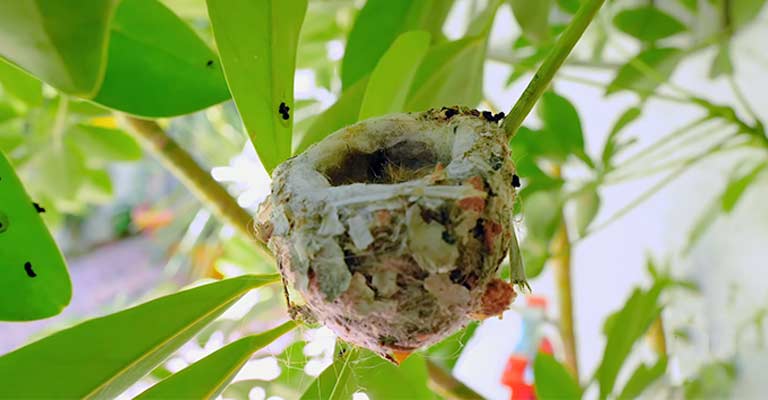The Antillean Crested Hummingbird (Orthorhyncus cristatus) is a captivating avian species endemic to the Caribbean, celebrated for its vibrant plumage and distinctive crested head.
With a petite stature and remarkable agility, these hummingbirds navigate tropical landscapes, including Puerto Rico, the Virgin Islands, and other Caribbean territories.
The species is marked by sexual dimorphism, with males displaying iridescent green or blue-green feathers and an ornate pointed crest, while females exhibit a more subdued greenish-gray plumage.
Renowned for their hovering abilities, Antillean Crested Hummingbirds feed on nectar from various flowering plants, supplementing their diet with small insects.
Their intricate nesting habits, diverse subspecies, and role in maintaining ecological balance underscore the significance of this species in the rich tapestry of Caribbean biodiversity.
The Antillean Crested Hummingbird stands as a testament to the natural marvels thriving in the vibrant and diverse ecosystems of the Caribbean region. Stay focused.
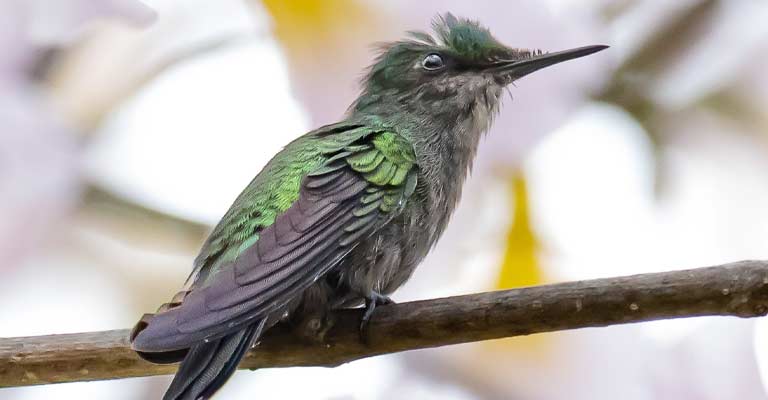
Identifying Characteristics of Antillean Crested Hummingbird
The Antillean Crested Hummingbird (Orthorhyncus cristatus) is a dazzling and distinctive species that can be found in the Caribbean region.
Identifying this captivating bird involves paying attention to several key characteristics that set it apart from other hummingbirds.
Here are some key points to help you distinguish the Antillean Crested Hummingbird:
Size and Shape
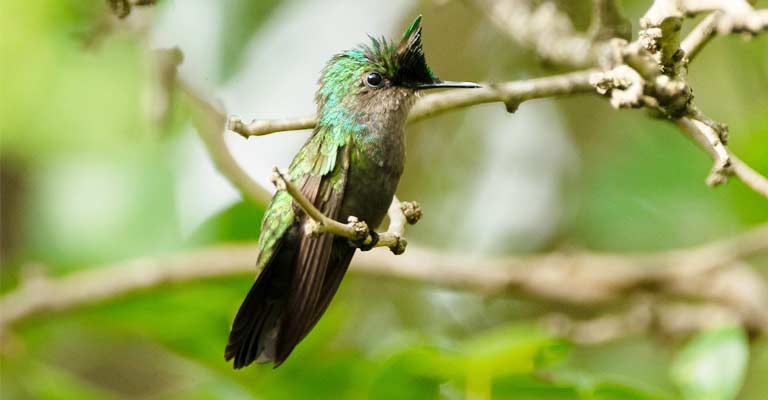
The Antillean Crested Hummingbird is a small-sized bird with a length of about 9 to 10 centimeters (3.5 to 4 inches).
Its slender and streamlined body, coupled with a long, straight bill, gives it a unique silhouette. The male typically has a slightly larger body compared to the female.
Coloration
One of the most striking features of the Antillean Crested Hummingbird is its vibrant plumage.
Males often boast an iridescent green or blue-green coloration on their upperparts, while the females tend to have a more subdued greenish-gray tone.
The throat and chest of both sexes may exhibit shades of white, blue, or violet.
Crested Head
As the name suggests, a distinctive feature of this hummingbird is the conspicuous crest on its head.
The male sports a flamboyant, pointed crest that is often erect, enhancing its overall regal appearance. In contrast, the female has a shorter, rounded crest.
Tail Feathers
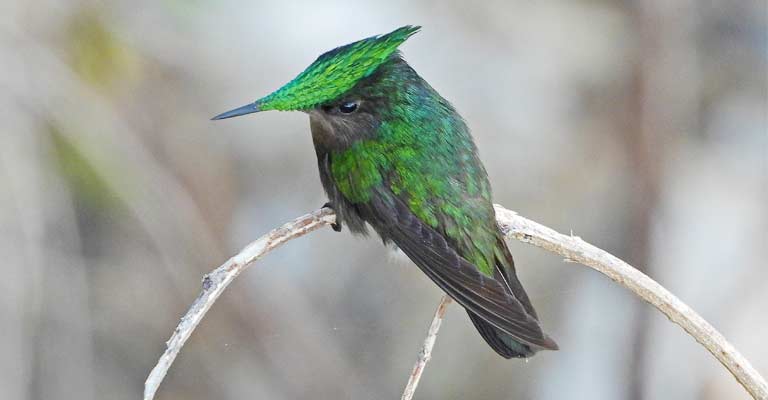
The tail feathers of the Antillean Crested Hummingbird are another distinguishing characteristic.
The male typically has long, pointed tail feathers that extend beyond its body, adding to its overall elegance. The female’s tail feathers are shorter and more rounded.
Behavior and Flight Pattern
Observing the flight pattern and behavior can aid in identification. The Antillean Crested Hummingbird exhibits agile and rapid flight, often hovering in mid-air while feeding on nectar.
Its ability to move swiftly and change direction with precision is a unique trait.
Habitat and Range
Knowing the bird’s habitat and geographical range is crucial for identification.
The Antillean Crested Hummingbird is primarily found in the Caribbean islands, including Puerto Rico, the Virgin Islands, and other surrounding areas.
It prefers a variety of habitats, including gardens, forests, and coastal areas.
Vocalizations
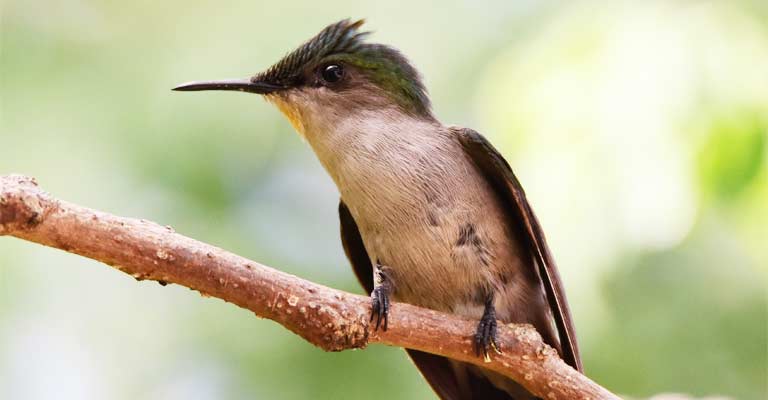
While not as vocal as some other bird species, the Antillean Crested Hummingbird may produce soft, high-pitched chirps or whistles.
Familiarizing yourself with its subtle vocalizations can contribute to accurate identification, especially when visual cues are limited.
Feeding Behavior
The feeding behavior of the Antillean Crested Hummingbird involves visiting flowers to sip nectar. Its long bill and specialized tongue are adapted for reaching deep into flowers.
This feeding habit, combined with its distinct appearance, sets it apart from other hummingbird species.
Recognizing the Antillean Crested Hummingbird involves a holistic approach, considering its size, coloration, crested head, tail feathers, behavior, habitat, vocalizations, and feeding habits.
By paying attention to these key characteristics, birdwatchers and enthusiasts can enjoy the unique beauty of this captivating hummingbird species in the Caribbean region.
Taxonomy of Antillean Crested Hummingbird
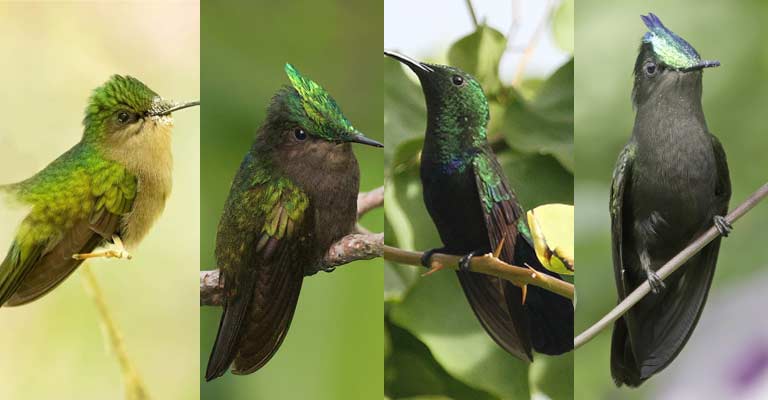
Here’s a table summarizing the taxonomy details of the Antillean Crested Hummingbird:
| Taxonomic Level | Classification |
| Domain | Eukaryota |
| Kingdom | Animalia |
| Phylum | Chordata |
| Class | Aves |
| Clade | Strisores |
| Order | Apodiformes |
| Family | Trochilidae |
| Tribe | Trochilini |
| Genus | Orthorhyncus Lacépède, 1799 |
| Species | O. cristatus |
This table outlines the hierarchical classification of the Antillean Crested Hummingbird, from the broad domain and kingdom to the more specific genus and species.
The taxonomic details provide a systematic framework for understanding the bird’s evolutionary relationships and its place within the broader spectrum of avian diversity.
The Antillean Crested Hummingbird (Orthorhyncus cristatus) exhibits notable diversity through its four recognized subspecies, each with its unique geographic distribution and characteristics:
- O. c. exilis (Gmelin, JF 1788) – Puerto Rico south through the Lesser Antilles to Saint Lucia: This subspecies inhabits a broad range, extending from Puerto Rico through the Lesser Antilles and reaching as far south as Saint Lucia. The Antillean Crested Hummingbirds in this category showcase adaptations to a variety of environments across these Caribbean islands.
- O. c. ornatus Gould, 1861 – Saint Vincent: Found specifically in Saint Vincent, this subspecies is characterized by distinctive features that set it apart from others. The localized nature of its distribution emphasizes the role of geographic factors in shaping the unique traits of this population.
- O. c. cristatus (Linnaeus, 1758) – Barbados: The Barbados subspecies raises intriguing questions about its origin, as studies have indicated considerable sequence divergence from its counterparts in Saint Lucia and Saint Vincent. This population’s potential invasion from an island other than Saint Lucia or Saint Vincent adds a layer of complexity to its evolutionary history.
- O. c. emigrans Lawrence, 1877 – Grenadines and Grenada: Inhabiting the Grenadines and Grenada, this subspecies showcases adaptations to the specific conditions prevailing in this region. Its distribution in the southern part of the Antillean Crested Hummingbird’s range contributes to the overall ecological diversity of the species.
The recognition of these subspecies highlights the evolutionary dynamics and geographical influences shaping the Antillean Crested Hummingbird populations across the Caribbean.
Studying the distinct characteristics of each subspecies provides valuable insights into the intricate patterns of avian diversity within this species.
Antillean Crested Hummingbird Life History
The Antillean Crested Hummingbird (Orthorhyncus cristatus), a captivating species endemic to the Caribbean region, boasts a fascinating life history marked by its unique adaptations and behaviors.
From its dietary preferences and choice of habitat to its nesting habits and breeding strategies, the life history of the Antillean Crested Hummingbird reflects its intricate relationship with the tropical ecosystems it inhabits.
Food
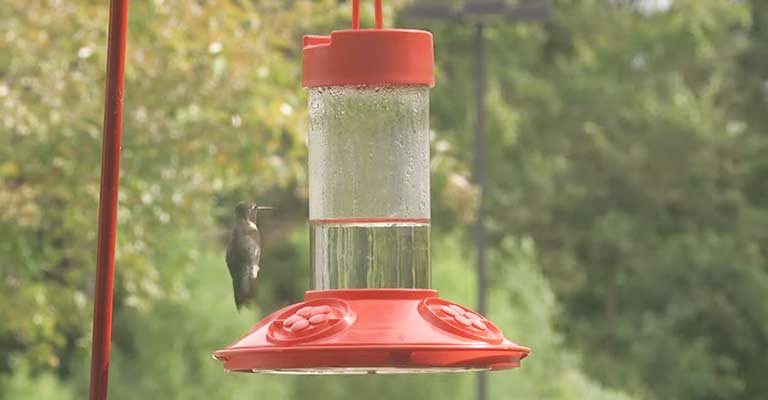
The primary diet of the Antillean Crested Hummingbird revolves around nectar from various flowering plants.
With its long, specialized bill and extendable, tube-like tongue, the bird adeptly collects nectar from deep within flowers.
In addition to nectar, these hummingbirds also consume small insects and spiders, providing essential proteins and nutrients, especially during the breeding season.
Habitat
Antillean Crested Hummingbirds exhibit a versatile habitat preference, making them adaptable to a range of environments.
They can be found in diverse settings, including tropical rainforests, gardens, coastal areas, and mountainous regions.
This adaptability allows them to exploit different nectar sources and thrive in various ecosystems throughout the Caribbean.
Range Map
The range of the Antillean Crested Hummingbird spans across several Caribbean islands, encompassing Puerto Rico, the Virgin Islands, and nearby territories.
A detailed range map showcases their distribution, highlighting the interconnectedness between these avian inhabitants and the varied landscapes they call home.
The nesting behavior of these hummingbirds is noteworthy for its intricacy. Females construct small cup-shaped nests using plant fibers, moss, and spider silk, often attaching them to the undersides of leaves.
The nests are carefully camouflaged with lichen, protecting them from predators.
A single clutch typically consists of two eggs, and the incubation period is relatively short, reflecting the species’ efficient reproductive strategy.
Here’s a table summarizing the nesting details of the Antillean Crested Hummingbird:
| Nesting Details | Antillean Crested Hummingbird |
| Clutch Size | Typically 2 eggs |
| Number of Broods | Usually 1 per breeding season |
| Egg Length | Approximately 1.0 cm (0.4 in) |
| Egg Width | Around 0.6 cm (0.2 in) |
| Incubation Period | Approximately 15 to 19 days |
| Nestling Period | About 20 to 25 days |
| Egg Description | Small, white eggs with a subtle pinkish tint; elliptical shape |
| Nest Construction | Cup-shaped nest made of plant fibers, moss, and spider silk, often camouflaged with lichen |
| Nest Placement | Attached to the undersides of leaves, protecting from predators |
| Parental Roles | Females are responsible for nest construction and incubation; both parents may feed the chicks |
| Courtship and Mating | Elaborate courtship displays by males, including aerial acrobatics and showcasing vibrant plumage |
This table provides a concise overview of key nesting characteristics and behaviors exhibited by the Antillean Crested Hummingbird.
Breeding
Breeding in the Antillean Crested Hummingbird is often influenced by the availability of food resources.
Males engage in elaborate courtship displays, showcasing their vibrant plumage and performing aerial acrobatics to attract potential mates.
Once paired, the female takes on the responsibility of nest construction and incubation, while the male may continue to defend the territory and assist in feeding the chicks after hatching.
Diseases
Like many bird species, the Antillean Crested Hummingbird is susceptible to various diseases, including those transmitted by parasites.
Common avian ailments, such as respiratory infections and external parasites, can impact the health of these birds.
Monitoring for signs of illness, such as lethargy or changes in plumage quality, is essential for the early detection of potential health issues.
Treatment
Veterinary intervention and research play a crucial role in addressing diseases in the Antillean Crested Hummingbird.
Understanding the specific pathogens affecting the population and implementing appropriate treatment strategies are essential for the conservation of this species.
Conservation efforts may involve captive breeding programs, habitat preservation, and public awareness campaigns to mitigate potential threats.
Conservation
Preserving the habitat and ensuring the availability of sufficient food resources are paramount for the conservation of the Antillean Crested Hummingbird.
Ongoing efforts to protect the diverse ecosystems within its range are critical, as habitat destruction and climate change pose significant threats.
Conservation initiatives may also include education programs to raise awareness about the importance of these charismatic hummingbirds and the role they play in maintaining ecological balance.
The life history of the Antillean Crested Hummingbird is a captivating narrative woven with the threads of adaptation, reproduction, and conservation.
Understanding the intricacies of their dietary habits, habitat preferences, breeding behaviors, and potential health challenges is essential for promoting the long-term survival of this remarkable species in the Caribbean.
10 Fun Facts About Antillean Crested Hummingbird
The Antillean Crested Hummingbird (Orthorhyncus cristatus) is a captivating species that not only contributes to the ecological diversity of the Caribbean but also possesses intriguing traits that make it a fascinating subject for bird enthusiasts.
Here are 10 fun facts about the Antillean Crested Hummingbird:
- Crested Crown Elegance: The Antillean Crested Hummingbird derives its name from the distinctive crest on its head. Males exhibit a pointed crest that can be raised and lowered, adding an element of regal elegance to their appearance.
- Vibrant Plumage Variations: While males showcase vibrant iridescent green or blue-green plumage, females boast a more subdued greenish-gray tone. The diversity in their coloring adds visual intrigue to the species.
- Miniature Marvels: Weighing in at just a few grams, the Antillean Crested Hummingbird is a true lightweight marvel. Its diminutive size contributes to its exceptional agility in flight.
- Hovering Maestros: These hummingbirds are accomplished hoverers, capable of maintaining a stationary position mid-air as they feed on nectar from flowers. Their swift and precise movements showcase their aerial mastery.
- Tongue Tactics: The specialized tongue of the Antillean Crested Hummingbird is adapted for extracting nectar from deep within flowers. This intricate adaptation allows them to efficiently access their primary food source.
- Cryptic Nests: Females exhibit a keen sense of nest construction, creating cup-shaped nests using plant fibers, moss, and spider silk. The nests are often camouflaged with lichen, providing excellent concealment from potential predators.
- Territorial Displays: Male Antillean Crested Hummingbirds are known for their territorial displays, which involve aerial acrobatics and showcasing their vibrant plumage. These displays play a crucial role in attracting potential mates.
- Short Incubation Period: The incubation period for Antillean Crested Hummingbird eggs is relatively short, lasting approximately 15 to 19 days. This rapid development is an adaptation to their dynamic and sometimes unpredictable environment.
- Dietary Duality: While their primary diet consists of nectar, Antillean Crested Hummingbirds also supplement their nutrition with small insects and spiders, showcasing a diverse and adaptable feeding strategy.
- Caribbean Natives: Endemic to the Caribbean region, these hummingbirds can be found in various islands, including Puerto Rico and the Virgin Islands. Their localized distribution adds to the uniqueness of the ecosystems they inhabit.
The Antillean Crested Hummingbird is not just a feathered marvel but a species with a myriad of enchanting traits that contribute to its charm and ecological significance in the Caribbean.
Wrapping Up
The Antillean Crested Hummingbird stands as a testament to nature’s intricate beauty and adaptability.
From its vibrant plumage to aerial acrobatics, the species captivates not only with its physical allure but also through its unique nesting habits and crucial role in Caribbean ecosystems.
The delicate balance of courtship displays, efficient nesting strategies, and agile foraging techniques underscores the resilience of this charismatic hummingbird.
Understanding its life history and appreciating its significance in the broader context of avian diversity emphasizes the importance of conservation efforts to ensure the continued flourishing of this remarkable species in the vibrant landscapes of the Caribbean. Best of luck.
